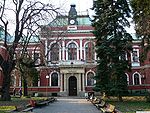- Kyustendil
-
Coordinates: 42°17′N 22°41′E / 42.283°N 22.683°E
Kyustendil
КюстендилThe medieval Church of St George in Kyustendil 
Coat of armsLocation of Kyustendil Coordinates: 42°17′N 22°41′E / 42.283°N 22.683°E Country Bulgaria Province
(Oblast)Kyustendil Government – Mayor Petar Paunov Elevation 513 m (1,683 ft) Population (Census February 2011) – City 44,416 – Urban 60,333 Time zone EET (UTC+2) – Summer (DST) EEST (UTC+3) Postal Code 2500 Area code(s) 078 License plate KH Kyustendil (Bulgarian: Кюстендил, historically Bulgarian: Велбъжд, Velbazhd) is a town in the far west of Bulgaria, the capital of Kyustendil Province, with a population of 44 416 (2011 census).[1] Kyustendil is situated in the southern part of the Kyustendil Valley, 90 km southwest of Sofia. It was named after the medieval lord of the surrounding region, Constantine Dragaš.
Contents
Geography
Kyustendil is a national balneological resort at an altitude of 500 metres. The ancient name of the town, Pautalia (a town of springs) is Thracian.[2]
There are more than 40 mineral springs in the town. The waters have a high content of sulfite compounds. These are used for the treatment of the locomotory system, gynecological and other kinds of diseases. The resort region includes several baths, balneological complexes and others.
Kyustendil is located at the foot of the Osogovo mountain, on both banks of the Banska River and is a well-known centre of balneology and fruit growing. The town is 90 kilometres southwest of Sofia, 69 km northwest of Blagoevgrad and 22 km from the border with the Republic of Macedonia and Serbia. The fortress was built by the Romans. Thermae, basilicas, floor mosaics have been uncovered.
History
A Thracian settlement was founded at the place of the modern town in the 5th-4th centuries BC and the Romans developed it into an important stronghold, balneological resort and trade junction called Pautalia in the 1st century AD. Many Thracian and Roman objects are exhibited in the city's Regional History Museum, most notably an impressive numismatic collection.
The Hisarlaka fortress was built in the 4th century and the town was mentioned under the Slavic name of Velbazhd (Велбъжд, meaning "camel")[2] in a 1019 charter by the Byzantine Emperor Basil II. It became a major religious and administrative centre.
During the reign of Kaloyan of Bulgaria, the town became part of the Second Bulgarian Empire, acquiring its modern name in the 16th century, named after local feudal lord Konstantin Dragash (ruled from 1379 to 1395).[2] In 1330 the Battle of Velbazhd took place in the vicinity of the town. After that war, the city came under Serbian rule, which lasted between 1330-1355. About 1355 Velbazhd and its region were included in the semi-independent feudal Velbazhd principality of Despot Deyan. In 1372 the Turks conquered the town. It was known as Köstendil under Ottoman rule. The name Köstendil was derived from Constantine Dragas' name. The city was a sanjak centre initially in Rumelia province, after that in the Bitola and Niš vilayets. It was a kaza centre in the Sofia sanjak of Danube Province until the creation of the Principality of Bulgaria in 1878.
The residents of Kyustendil took an active part in the Bulgarian National Revival and crafts and trade flourished. The town was liberated from Ottoman rule on 29 January 1878.
Honour
Pautalia Glacier on Livingston Island in the South Shetland Islands, Antarctica is named after Pautalia (the Thracian name for the settlement).
Notable people
- Constantine Dragaš, 14th-century local ruler
- Ilyo Voyvoda (1805–1898), hajduk, revolutionary and Bulgarian liberation fighter (died in Kyustendil)
- Dimitar Peshev (1894–1973), World War II Minister of Justice and Deputy speaker of the Parliament who prevented the deportation of the Bulgarian Jews to Nazi death camps
- Todor Angelov (1900–1943), communist revolutionary and Belgian resistance fighter
- Nikolay Diulgheroff (1901–1982), futurist artist
- Marin Goleminov (1908–2000), composer
Gallery
-
The municipality hall (architect Friedrich Grünanger)
-
10th-11th century Church of St George in the Kolusha neighbourhood
References
- ^ Население - градове в България - „НСИ“
- ^ a b c Adrian Room, "Placenames of the World" ISBN 0-7864-2248-3 McFarland & Company (2005)
External links
- http://kn.government.bg/index.php?lang=en/Provides information about the region, photos, historical review, and development projects
- Kyustendil tourist destination - tourism opportunities in the Kyustendil region
- Kustendil Info, Information web Portal of Kyustendil
- KnCity.info, a website about Kyustendil
- Kyustendil at Journey.bg
- Kyustendil at BGGlobe
- Regional History Museum
Boboshevo · Bobov Dol · Dupnitsa · Kocherinovo · Kyustendil · Nevestino · Rila · Sapareva Banya · Treklyano
Capital: KyustendilVillages Bagrentsi, Bersin, Blatets, Bobeshino, Bogoslov, Bunovo, Chudentsi, Dvorishte, Dozhdevitsa, Dolna Gradishnitsa, Dolno Selo, Dolno Uyno, Dragovishtitsa, Girchevtsi, Goranovtsi, Gorna Brestnitsa, Gorna Grashtnitsa, Gorno Uyno, Gramazhdano, Granitsa, Gurbanovtsi, Garbino, Garlyano, Gyueshevo, Ivanovtsi, Kamenichka Skakavitsa, Katrishte, Konyavo, Kopilovtsi, Kopriva, Kutugertsi, Karshalevo, Lelintsi, Leska, Lisets, Lozno, Lomnitsa, Mazarchevo, Vratsa, Novi Chiflik, Novo Selo, Nikolichevtsi, Piperkov Chiflik, Poletintsi, Polska Skakavitsa, Prekolnitsa, Radlovtsi, Ranentsi, Rezhintsi, Razhdavitsa, Rasyovo, Savoyski, Sazhdenik, Shipochano, Shishkovtsi, Skrinyano, Slokostitsa, Sovolyano, Stensko, Tavalichevo, Tarnovlak, Tarsino, Tserovitsa, Tsreshnovo, Tsarvena Yabalka, Tsarvendol, Tservelyano, Yabalkovo, Zhabokrat, Zheravino, Zhilentsi
Landmarks Church of St St Cyril and Methodius, Church of St John the Baptist, Church of St Archangel Michael, Church of the Holy Spirit, Church of St Demetrius, Church of St George, Church of St Athanasius, Church of St Eljiah, Granitsa House, Granitsa Monastery, Granitsa Fortress, Church of St George, Zheravino, Church of St Nicholas, Church of St Yoakim of Osogovo, Church of St Paraskeva, Church of St George, Lomnitsa, Church of St Peter and Paul, Annunciation Church, Church of St Nicholas, Slokostitsa, Church of St Petka, Roman Baths of Kyustendil, Hisarlaka Fortress, Church of St George, Kyustendil, Church of the Assumption of Mary, Church of St Demetrius, Kyustendil, Church of St Mina, Church of St Martyr Mina, Vladimir Dimitrov - Maystora Art GalleryCulture Notable people Categories:- Spa towns in Bulgaria
- Populated places in Bulgaria
- Kyustendil Province
- Kyustendil
Wikimedia Foundation. 2010.













